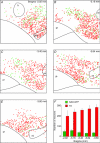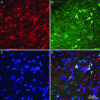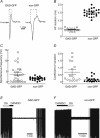Distinct cellular properties of identified dopaminergic and GABAergic neurons in the mouse ventral tegmental area
- PMID: 21646409
- PMCID: PMC3171885
- DOI: 10.1113/jphysiol.2011.210807
Distinct cellular properties of identified dopaminergic and GABAergic neurons in the mouse ventral tegmental area
Abstract
The midbrain ventral tegmental area (VTA) contains neurons largely with either a dopaminergic (DAergic) or GABAergic phenotype. Physiological and pharmacological properties of DAergic neurons have been determined using tyrosine hydroxylase (TH) immunohistochemistry but many properties overlap with non-DAergic neurons presumed to be GABAergic. This study examined properties of GABAergic neurons, non-GABAergic neurons and TH-immunopositive neurons in VTA of GAD67-GFP knock-in mice. Ninety-eight per cent of VTA neurons were either GAD-GFP or TH positive,with the latter being five times more abundant. During cell-attached patch-clamp recordings, GAD-GFP neurons fired brief action potentials that could be completely distinguished from those of non-GFP neurons. Pharmacologically, the μ-opioid agonist DAMGO inhibited firing of action potentials in 92% of GAD-GFP neurons but had no effect in non-GFP neurons. By contrast, dopamine invariably inhibited action potentials in non-GFP neurons but only did so in 8% of GAD-GFP neurons. During whole-cell recordings, the narrower width of action potential in GAD-GFP neurons was also evident but there was considerable overlap with non-GFP neurons. GAD-GFP neurons invariably failed to exhibit the potassium-mediated slow depolarizing potential during injection of positive current that was present in all non-GFP neurons. Under voltage-clamp the cationic current, I(h), was found in both types of neurons with considerable overlap in both amplitude and kinetics. These distinct cellular properties may thus be used to confidently discriminate GABAergic and DAergic neurons in VTA during in vitro electrophysiological recordings.
Figures







References
-
- Cameron DL, Wessendorf MW, Williams JT. A subset of ventral tegmental area neurons is inhibited by dopamine, 5-hydroxytryptamine and opioids. Neuroscience. 1997;77:155–166. - PubMed
-
- Franklin KB, Paxinos G. The Mouse Brain in Stereotaxic Coordinates. Academic Press; 1997.
-
- Garzon M, Pickel VM. Plasmalemmal mu-opioid receptor distribution mainly in nondopaminergic neurons in the rat ventral tegmental area. Synapse. 2001;41:311–328. - PubMed
Publication types
MeSH terms
Substances
LinkOut - more resources
Full Text Sources
Molecular Biology Databases
Research Materials

